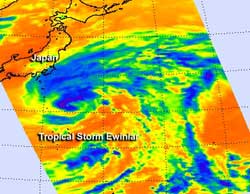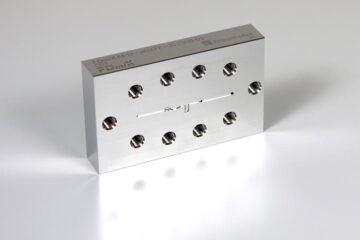NASA Sees Tropical Storm Ewiniar Embedded in Low Pressure

This infrared image was created from AIRS data of Tropical Storm Ewiniar on Sept. 27 at 0323 UTC as the storm nears eastern central Japan. The strongest thunderstorms with very cold cloud top temperatures appear in purple. Credit: NASA JPL/Ed Olsen<br>
As Tropical Storm Ewiniar continues to move northward it wound up in an elongated area of low pressure (called a trough) off Japan's east coast. The trough is bringing a strong westerly flow of air into Ewiniar.
Despite being battered by those winds, infrared data from the Atmospheric Infrared Sounder (AIRS) instrument that flies aboard NASA's Aqua satellite is showing that Ewiniar is managing to keep its tropical characteristics. AIRS data on Sept. 27 at 0323 UTC revealed that there is still strong thunderstorms in a band over the northern semi-circle, and weaker bands of thunderstorms around the rest of Ewiniar.
On Sept. 27 at 1500 UTC (11 a.m. EDT, Tropical Storm Ewiniar had maximum sustained winds near 55 knots (63.2 mph/102 kmh). It was located near 31.8 North and 141.9 East, about 265 nautical miles (305 miles/491 km) south-southeast of Tokyo, Japan. Ewiniar is moving to the north-northwest 6 knots (7 mph/11 kmh) and is expected to turn to the north-northeast over the next several days, taking it away from Japan.
Text credit: Rob Gutro
NASA's Goddard Space Flight Center, Greenbelt, Md.
Media Contact
All latest news from the category: Earth Sciences
Earth Sciences (also referred to as Geosciences), which deals with basic issues surrounding our planet, plays a vital role in the area of energy and raw materials supply.
Earth Sciences comprises subjects such as geology, geography, geological informatics, paleontology, mineralogy, petrography, crystallography, geophysics, geodesy, glaciology, cartography, photogrammetry, meteorology and seismology, early-warning systems, earthquake research and polar research.
Newest articles

Physicists arrange atoms in extremely close proximity
The technique opens possibilities for exploring exotic states of matter and building new quantum materials. Proximity is key for many quantum phenomena, as interactions between atoms are stronger when the…

For microscopic organisms, ocean currents act as ‘expressway’ to deeper depths
New research shows how tiny plant-like organisms hitch a ride on ocean currents to reach darker and deeper depths, where they impact carbon cycling and microbial dynamics in the subtropical…

FDmiX: Fast, robust series production of nanoparticles
Nucleic acid-based medications such as mRNA vaccines are opening up new therapeutic approaches. These active ingredients must be enclosed inside nanoparticles to ensure that they get to where they are…





















